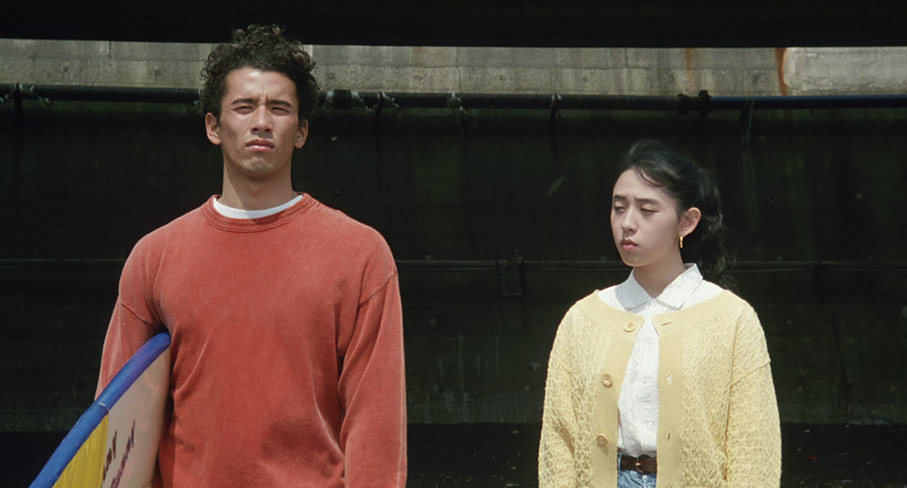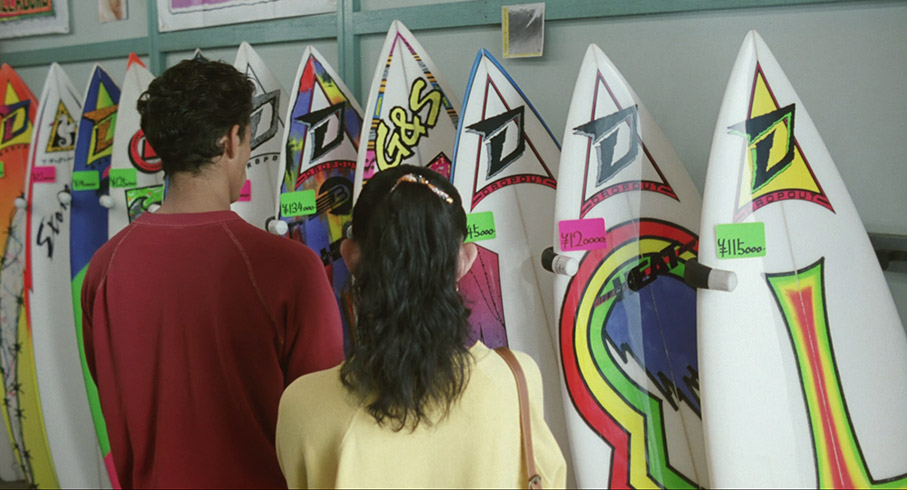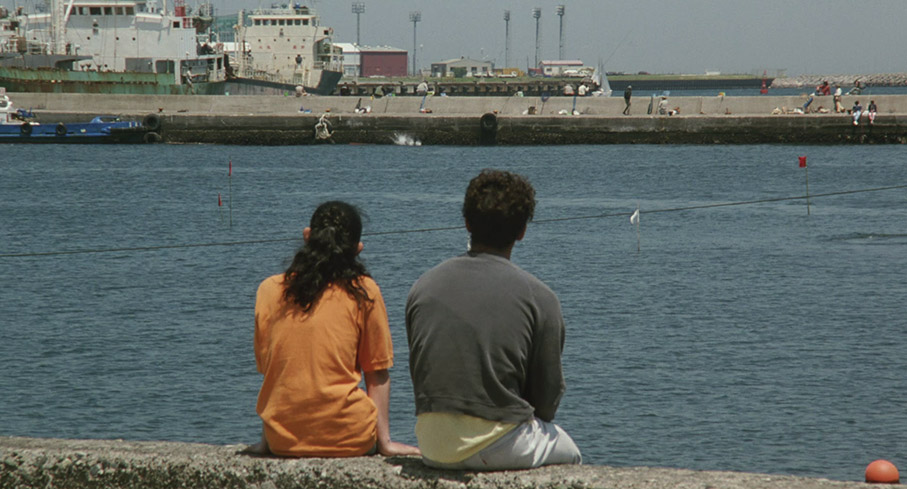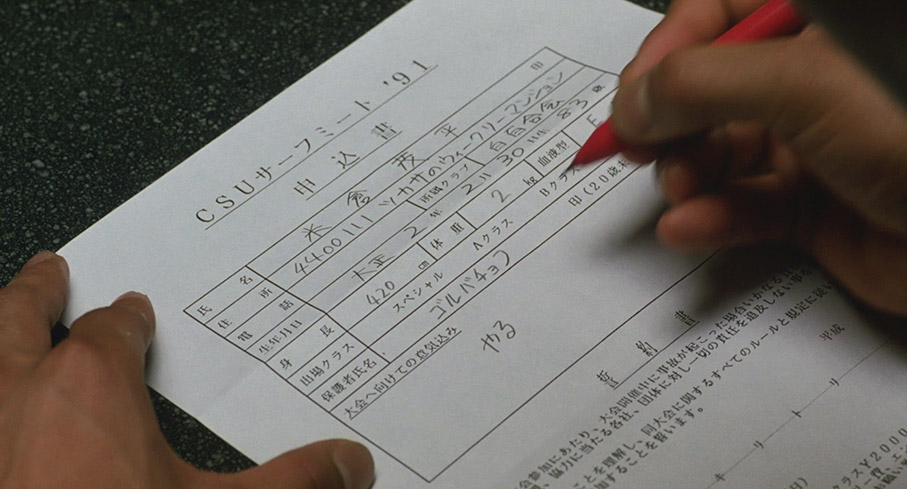|
Note: This review has been updated from our 2006 review of Second Sight's DVD release of the film.
Back when Kitano Takeshi's delightful comedy-drama Kikujiro first hit UK shores, a too common remark made in its critical evaluation was that it finally provided evidence that Kitano could make a non-violent, non-gangster film and do a damned fine job of it. Every time I read this I had this urge to find the reviewer in question and yell at them: "What about A Scene at the Sea?" But then, at the time of Kikujiro's release, precious few UK viewers seemed to have even heard of the earlier film, let alone seen it.
A Scene at the Sea, whose actual Japanese title is Ano natsu, ichiban shizukana umi – which translates literally, and a lot more poetically, as 'That Summer, the Quietest Sea' – was Kitano's third film as director after Violent Cop [Sono otoko, kyôbô ni tsuki] and Boiling Point [3-4 x jûgatsu], and it remains probably the boldest film of his pre-Dolls period. Hell, by most filmmaker's standards this is still seriously chance-taking stuff. Imagine taking this proposition to a Hollywood studio: we want to make a film whose lead characters are a deaf-mute couple who not only don't say a word to each other (well, obviously), but they don't sign either, and there's no William Hurt stand-in to vocalise for the audience what they would say if they did. Fabulous. Don't slam the door on your way out. But for the more adventurous viewer this should present an intriguing prospect. With much of the film playing with no dialogue at all, it's down to the body language and facial expressions of the performers and the shot choice and editing skills of the director to tell the story. And you only need to have seen one of Kitano's other directorial works to know that this is a long way from a tall order.

The story revolves around introspective deaf-mute dustman Shigeru, whose discovery of a broken surfboard awakens something in him that he attempts to satisfy by repairing the board and trying his hand at surfing. His efforts prompt derisive laughter from the beach regulars, but the oblivious Shigeru persists in his efforts nonetheless. When the board eventually breaks, he and his girlfriend Takako try to negotiate a deal on a new one, something they can ill afford but which by now has become important to Shigeru. As he continues to practice, his improving skills and determination earn the respect of the other surfers, and he is eventually encouraged by local surf shop owner Nakajima to take part alongside them in a regional surfing competition.
If this has you expecting a Japanese Big Wednesday then you need to rethink your assumptions. The surfing itself is almost background action here and for much of the time is shot wide from the viewpoint of observers or not shown at all, with the camera instead focussed on the reactions of spectators. Nor does the competition itself play to expectations and convention (hop to the next paragraph if you want to avoid a spoiler), with Shigeru never even getting the chance to demonstrate his improved skills because he is unable to hear his turn to compete being called.
In typical Kitano fashion, the gentle pace and tone remain consistent throughout, which is made more evident than in his previous two films by the complete absence of their sudden explosions of violence. There's a pictorially observational quality here emphasised by the scarcity of angled shots, with the camera regularly positioned parallel or perpendicular to architecture and background, and characters shot either from the side or head-on, giving some compositions the feel of animated murals. At times it's almost as if Kitano is constructing his drama from carefully composed stills rather than moving imagery, but such sequences remain resolutely cinematic in their use of sound and music, in the subtle changes in facial expression, in the movements of characters and background action, and in the waste-free scene construction and precision editing. When the camera does move it does so almost invisibly, panning or tracking with characters as they walk, far and away the film's primary mode of transport.

Kitano's signature editing style feels honed to perfection here, lingering on shots just long enough for us to discover his reason for doing so and compressing action into two or three juxtaposed (and sometimes static) images in a manner that often negates the need for explanatory dialogue. This results in a story told primarily in visual terms, with what dialogue there is consisting mainly of chit-chat between secondary characters and having little bearing on the narrative development. Such an approach would offer a challenge even for an action-based film, where cause-and-effect storytelling tends to provide the necessary plot signposts. But for one exploring the slow development of an unemotionally expressed passion and the changing nature of a wordless relationship, it's a small miracle that it works at all, let alone that it does so in such divine fashion. Indeed, so beautifully and unobtrusively does the story unfold that you become acutely aware of how overstated most other relationship dramas feel by comparison, how heavily their plot points are hammered home, how clumsy their exposition, and how vigorously the buttons are pushed to prompt the required emotional response.
A connection to the director's comedy roots and a pointer to similar character pairings in films to come is provided by two unnamed members of a local amateur football team that we can assume Shigeru once played for (like many character details, this is subtly suggested rather than stated outright), a hapless but energetic duo who loudly mock Shigeru's initial efforts, but are soon over-enthusiastically attempting to follow in his footsteps. In doing so, they also become part of a cycle of surf life at the beach, inheriting the inexperienced newcomer position previously occupied by Shigeru and his immediate successor, a cocky but inept young hopeful whose girlfriend's attempts to court Shigeru's friendship fire a spark of jealousy in Takako, who is already coming second place to her boyfriend's new obsession. Later, their persistence sees them move up the community pecking order, much as Shigeru did before them, with his donation of a wetsuit to the pair (which they comically fight over, of course) repeating an earlier ritual of communal acceptance and encouragement shown to him by Nakajima.

Familiar themes and situations abound, but almost never play out in the expected fashion. Shigeru's all-encompassing obsession may lead to him neglecting both his job and his girlfriend, but the resulting conflicts have none of the overwrought histrionics of Hollywood dramas and are settled in the same low key manner in which they arise. Similarly, there's little drama to Shigeru's competition losses and wins, reflecting his own initial indifference to this aspect of the sport – on the first competition entry form he dismissively puts his name down as Gorbachev, which is then corrected by the loyal and ever-patient Takako (see sound and vision details below for more on this).
A Scene at the Sea is a hugely important film in Kitano's development as a filmmaker, one in which he discards his dramatic safety net to tell a small story in resolutely minimalist fashion, and in the process scores a bold and quietly brilliant bulls-eye. There's no violence (a comical struggle between police and an irate van driver played by Kitano favourite Terajima Susumu is as near as it comes), precious little dialogue, and the tone and pacing vary little throughout, and yet the hold exerted by the characters and storytelling is considerable. The dramatic punch delivered by the final scenes is also disarmingly effective, all the more so for its partial reliance on suggestion and audience recall.
It's in this film that the director's love affair with the ocean and the seashore finds one of its purest cinematic expressions, something that would be carried over into his sublimely realised follow-up film, Sonatine. It also marks his first collaboration with composer and Studio Ghibli regular Hisaishi Joe, whose scores would become an essential component of the Kitano style from this point on. Certainly much of the film's emotional clout comes from Hisaishi's gorgeous score, particularly in the way it is married to the action, heightening the emotion of sequences whose visual drama is reduced to a look, a juxtaposition of images, or the position of characters within frame. Takako's late-film second encounter with the van driver is a wonderfully underplayed example of this, where the expressions and the editing tell us everything we need to know about the conversation they simply don't need to have, while the slow build of the music to a final montage of memories creates a sequence that is genuinely moving but never slips for a moment into sentimentality.

A Scene at the Sea established beyond all question Kitano's singular skill as both a storyteller and a filmmaker, something that is too rarely associated with this particular film because it speaks in confident whispers instead of shouting its qualities in the manner of more attention-grabbing early works from any number of younger filmmakers the world over. Rarely screened and too often sidelined by the director's more widely seen films, A Scene at the Sea remains to this day one of his most assured, poetic and yet gently unassuming cinematic achievements, and one of my very favourite Kitano Takeshi films.
Of all the discs in Second Sight's Kitano Takeshi DVD collection, A Scene at the Sea was one of the best, but even that didn't prepare me for just how good it looks on this excellent new 1080p transfer. The sharpness and level of picture detail is consistently impressive and intermittently striking, with lettering on background objects that was indistinct on the DVD being clearly legible here, assuming you can read Japanese of course. The colours are naturalistic but pop when appropriate, with a richness to prime colours that shines without ever feeling over-saturated. Contrast is very nicely pitched throughout, with solid black levels and strong shadow detail. The image is also spotless and sits solidly in frame, and is framed in the original 1.85:1.
The Linear PCM 2.0 stereo soundtrack is also in fine shape, being very clear and boasting a subtly strong dynamic range. Joe Hisaishi's score sounds lovely throughout, and there's a fullness to the surf and breaking waves that creates a vivid sense of place.
The optional English subtitles are clear and HD crisp, and have clearly been subject to a new translation and not simply copied over from those on the Second Sight DVD. This does correct one of the small gripes I had with that disc by translating some of the small talk that takes place between the surfers, something that was absent on the earlier release – what is said may be largely inconsequential, but it's more involving to know what's being said nonetheless and know for sure that you're not missing anything important. The translation of some lines differs from that on the DVD, more accurately reflecting the price of a purchase at Nakajima's surf shop, with a somewhat unlikely 42 million yen for a small piece of surfing gear (that's over £300,000 at today's ludicrous post-referendum exchange rates) more accurately priced here at 4,200 yen, which converts to a more reasonable £30. In this same scene, however, one brief exchange that was translated in full on the DVD is here missing the final jocular dig, as Nakajima's claim that he has no time to join the surfers at the beach because he is too busy prompts the cheerfully sarcastic repost, "You? Busy?" This, just so you know, is why the laughing Nakajima nearly throws his marker pen at the youth who delivers this line.

What did surprise me is that my biggest complaint of an absent subtitle on the Second Sight disc is also not translated here. It comes when Shigeru is filling out the entry form for the first surfing competition, and instead of writing his own name he writes the Japanese equivalent of Gorbachev ("Gorubachofu") in katakana, a written alphabet used almost exclusively for non-Japanese words (and if you somehow have never heard the name Mikhail Gorbachev then a quick internet search will land you a few million hits). The document is shown in close-up as Shigeru writes the name specifically so that this will register and we will thus understand why Takako then immediately sets about correcting it. But it also provides the only clear indication that Shigeru is genuinely not that bothered about the competition and is likely surfing purely for the enjoyment and challenge he gets from the activity, which by turn impacts on our understanding of his actions towards the film's end.
Commentary by Jasper Sharp
If the name Jasper Sharp is new to you then I'm guessing that you've not spent much time reading Midnight Eye, which for my money is the best English language web site on Japanese cinema anywhere on the net. Sharp was its co-founder with the equally knowledgeable and passionate Tom Mes, whose commentaries have also graced a number of UK Blu-ray and DVD releases and whose books on Tsukamoto Shinya should be considered essential reading for all fans of that most distinctive of outsider filmmakers. As a long-standing fan of the film, I was expecting to find myself in largely familiar ground here, but how wrong I was – during the course of this commentary I learned so much about the film, its performers and those working behind the camera that by the end I felt almost as if I'd just read a well researched and detailed book on the subject. Although only occasionally screen specific, the sheer volume of information delivered here and the enthusiasm with which it is put across makes this an essential and excellent companion to the film. The examples Sharp picks from the Japanese resurgent cinema of the 80s and 90s should also be on your watch list (I, too, was enthusiastically promoting the merits of Kurosawa Kiyoshi's Cure long before it was available in the UK), but we parted company with a bang on Kitano's later Dolls, a mesmerising work that Sharp can't think of a good thing to say about but I have trouble finding any real fault with. It matters not – this is exactly the sort of expert commentary all such films deserve but rarely get.
One of Kitano Takeshi's most gentle and poetic films as director (and the first from his production company, Office Kitano) is also one of his very finest, a beautifully realised tale of an outsider who almost unwittingly finds himself embraced by a community he seems almost indifferent to in his single-minded determination to master a new and chance discovered obsession. Yet, as has been noted elsewhere, this is actually more Takako's story than Shigeru's, something that really registers in the moving finale. Third Window's Blu-ray sports a lovely transfer, and while it has only one extra, it's an absolute corker, and the disc thus comes highly and enthusiastically recommended.
The Japanese convention of surname first has been used for Japanese names throughout this review.
|